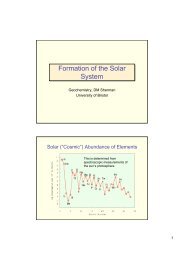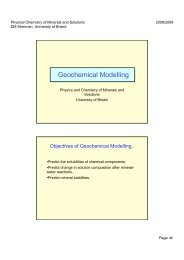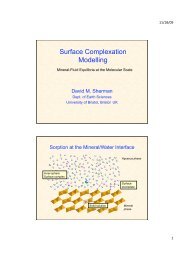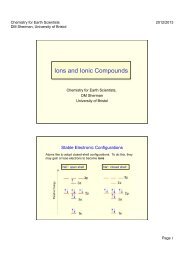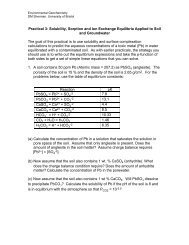Practical 5:Redox Equilibria
Practical 5:Redox Equilibria
Practical 5:Redox Equilibria
Create successful ePaper yourself
Turn your PDF publications into a flip-book with our unique Google optimized e-Paper software.
Chemistry for Earth Sciences<br />
<strong>Practical</strong> 5: <strong>Redox</strong> <strong>Equilibria</strong> and the Phase Rule<br />
(WORKED SOLUTIONS)<br />
1. In the pe-pH diagram below, the possible species and phases are<br />
Fe +3 (aqueous)<br />
Fe(OH) 3 (solid)<br />
FeS 2 (pyrite)<br />
FeCO 3 (siderite)<br />
Fe(OH) 2 (solid)<br />
KFe 3 (OH) 6 (SO 4 ) 2 (Jarosite)<br />
Try to work out which species/phases occupy which stability fields<br />
Solution:<br />
20<br />
15<br />
Fe+3<br />
Σ CO3 = 0.001 m<br />
Σ S = 0.01 m<br />
Σ K = 0.001 m<br />
Jarosite<br />
10<br />
pe<br />
5<br />
Fe+2<br />
Fe(OH)3<br />
0<br />
FeCO3<br />
-5<br />
FeS2<br />
-10<br />
0 2 4 6 8 10 12 14<br />
pH<br />
Fe(OH)2<br />
2. Near a sulfide ore body, the minerals pyrite (FeS 2 ), chalcopyrite (CuFeS 2 )<br />
bornite (Cu 5 FeS 4 ), and covellite (CuS) are present. How many components<br />
are in this assemblage? How many degrees of freedom does the phase<br />
assemblage have?
Solution: there are three components (Fe, Cu and S), four phases and,<br />
therefore f = 3-4+2 = 1 degree of freedom (i.e., at a given pressure, this<br />
phase assemblage can exist only at 1 temperature).<br />
3. Consider the system (Mg,Ca)CO 3 (s) + aqueous solution (with H 2 O + Mg +2<br />
Ca +2 + CO 3 -2 + H 2 CO 3 + HCO 3<br />
- + OH - + H + ) + CO 2 (g). Note that the notation<br />
(Mg,Ca)CO 3 means that the phase is a solid solution between MgCO 3 and<br />
CaCO 3 . How many phases, components and degrees of freedom does this<br />
system have?<br />
Solution: There are three phases ((Mg,Ca)CO3(s) + aqueous solution + gas)<br />
and we need 4 components to describe every species/phase. This gives f= 4-<br />
3+2 = 3 degrees of freedom. If we fix P and T, we have 1 degree of freedom.<br />
This extra degree of freedom could be PCO2 (P = partial pressure), pH or<br />
Mg/Ca.<br />
If we know one of these, we then know the others.<br />
4. Consider the redox reaction<br />
CH 2 O + 3NO 3<br />
-<br />
= CO 2 + H 2 O + 3NO 2<br />
-<br />
Which species is being oxidized and which is being reduced? What is the<br />
change in oxidation state for C and the change for N? Can you decompose<br />
this reaction into two half-reactions?<br />
Solution: Carbon is being oxidized from 0 to +4. Nitrogen is being reduced<br />
from +5 to +3. The half-reactions are:<br />
CH2O + H2O = CO2 + 4e- + 4H+<br />
NO3- + 2e- + 2H+ = NO2- + H2O<br />
5. The pK for the reaction<br />
MnO 2 (s) + 4H + + 2e- = Mn 2+ + 2H 2 O<br />
Is -41.4. Calculate the pe when MnO 2 (s) is present, the pH is 6.5 and the<br />
concentration of dissolved Mn +2 is 10 -5 m.<br />
Solution:<br />
pK = p[Mn+2] – 4pH -2pe<br />
-41.4 = 5-4(6.5) – 2pe to give pe = 10.2
6. Balance the following redox reactions and work out the two half-reactions:<br />
a) CH4 + O2 = CO2(g) + H2O(g)<br />
b) Fe(OH)3 + H2S = FeS + S + H2O<br />
c) CH2O = CH4 + CO2<br />
d) CH2O + NO3 - + H + = CO2 + H2O + NH4 +<br />
e) Nitrogen fixation:<br />
NH4 + + O2 = NO3 - + H + + H2O<br />
Solution:<br />
a) CH4 + O2 = CO2(g) + 2H2O(g)<br />
CO 2 + 4e- + 4H+ = CH 4<br />
O 2 + 4e- + 4H+ = 2H 2 O<br />
b) Fe(OH)3 + 3/2 H2S = FeS + 1/2 S + 3 H2O<br />
Fe(OH) 3 + e- + H+ + H 2 S = FeS + 3H 2 O<br />
1/2 S + e- + H+ = 1/2 H 2 S<br />
c) CH2O = CH4 + CO2<br />
CH2O + 4e- + 4H+ = CH4 + H2O<br />
CO 2 + 4e- + 4H+ = CH 2 O + H 2 O<br />
d) 2CH2O + NO3 - + 2H + = 2CO2 + H2O + NH4 +<br />
2CO 2 + 8e - + 8H+ = 2CH 2 O + 2H 2 O<br />
NO 3 - + 8e- + 10H+ = NH 4 + + 3H 2 O<br />
e) NH4 + + 2O2 = NO3 - + 2H + + H2O<br />
NO 3 - + 8e- + 10H+ = NH 4 + + 3H 2 O<br />
2 O 2 + 8e- + 8H+ = 4H 2 O



